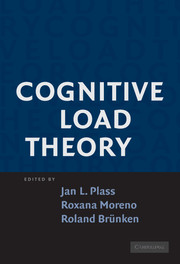Book contents
- Frontmatter
- Contents
- Contributors
- COGNITIVE LOAD THEORY
- Introduction
- PART ONE THEORY
- 1 Cognitive Load Theory: Historical Development and Relation to Other Theories
- 2 Cognitive Load Theory: Recent Theoretical Advances
- 3 Schema Acquisition and Sources of Cognitive Load
- 4 Individual Differences and Cognitive Load Theory
- PART TWO EMPIRICAL EVIDENCE
- PART THREE DISCUSSION
- Index
- References
2 - Cognitive Load Theory: Recent Theoretical Advances
Published online by Cambridge University Press: 05 June 2012
- Frontmatter
- Contents
- Contributors
- COGNITIVE LOAD THEORY
- Introduction
- PART ONE THEORY
- 1 Cognitive Load Theory: Historical Development and Relation to Other Theories
- 2 Cognitive Load Theory: Recent Theoretical Advances
- 3 Schema Acquisition and Sources of Cognitive Load
- 4 Individual Differences and Cognitive Load Theory
- PART TWO EMPIRICAL EVIDENCE
- PART THREE DISCUSSION
- Index
- References
Summary
Cognitive Load Theory (CLT) began as an instructional theory based on our knowledge of human cognitive architecture. It proved successful in generating a series of cognitive load effects derived from the results of randomised, controlled experiments (Clark, Nguyen, & Sweller, 2006). This chapter summarises the theory, including its general instructional implications. Many of the theory's specific instructional implications, which provide its prime function and purpose, are discussed in other chapters in this volume and therefore will not be discussed in detail in this chapter (see Table 2.1 for a summary).
HUMAN COGNITION
The processes of human cognition constitute a natural information-processing system that mimics the system that gave rise to human cognitive architecture: evolution by natural selection. Both human cognition and biological evolution create novel information, store it for subsequent use, and are capable of disseminating that information indefinitely over space and time. By considering human cognition within an evolutionary framework, our understanding of the structures and functions of our cognitive architecture are being transformed. In turn, that cognitive architecture has profound instructional consequences. CLT is an amalgam of human cognitive architecture and the instructional consequences that flow from that architecture.
From an evolutionary perspective, there are two categories of human knowledge: biologically primary and biologically secondary knowledge (Geary, 2007, 2008). Biologically primary knowledge is knowledge we have evolved to acquire over many generations. Examples are general problem-solving techniques, recognising faces, engaging in social relations, and listening to and speaking our native language.
- Type
- Chapter
- Information
- Cognitive Load Theory , pp. 29 - 47Publisher: Cambridge University PressPrint publication year: 2010
References
- 184
- Cited by

